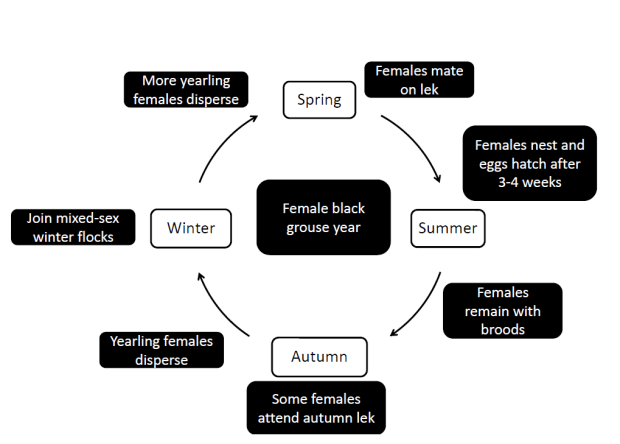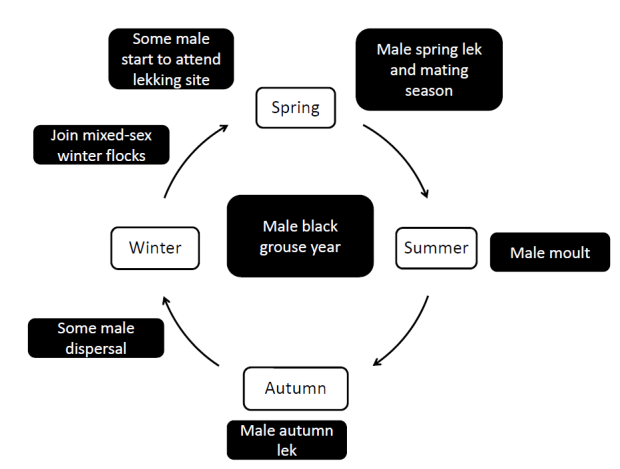The lifecycle of black grouse
Female lifecycle
 Female black grouse have the more complicated lifecycle. Broadly it can split into three sections. In spring, females attend leks to mate. Females then move away into the surrounding forest to summer ranges where they build a simple nest and lay 6-11 eggs. After 3 weeks the eggs hatch. The chicks are precocial and immediately leave the nest. Chicks initially eat invertebrates and are able to fly by the age of 3 weeks. Females and brood remain together till the autumn when males begin to leave the family group. Females may attend the autumn lek to evaluate males early. Young females can disperse in October and again in spring. Female dispersal is an important inbreeding avoidance mechanism (Lebigre et al. 2010). Females join mixed-sex winter flocks through the winter, before males start attend the spring leks.
Female black grouse have the more complicated lifecycle. Broadly it can split into three sections. In spring, females attend leks to mate. Females then move away into the surrounding forest to summer ranges where they build a simple nest and lay 6-11 eggs. After 3 weeks the eggs hatch. The chicks are precocial and immediately leave the nest. Chicks initially eat invertebrates and are able to fly by the age of 3 weeks. Females and brood remain together till the autumn when males begin to leave the family group. Females may attend the autumn lek to evaluate males early. Young females can disperse in October and again in spring. Female dispersal is an important inbreeding avoidance mechanism (Lebigre et al. 2010). Females join mixed-sex winter flocks through the winter, before males start attend the spring leks.

Male grouse lifecycle
In contrast to females, males have a relatively simple lifecycle. Like young females, young males may disperse in autumn and spring, but they dispere less frequently and much shorter distances. In general, male grouse time is divided into attending the lek and not attending the lek. Following the spring mating season, male grouse moult and males generally do not lek throughout the summer. This is peak period of male mortality (Alatalo et al. 1991). By autumn, males have again gathered on the lek for the autumn lek. Males then spend the winter in mixed-sex flocks, but gradually males leave these flocks and more and more males again start defending sites on the lek, building again towards the spring lek and mating season. Males are much more philopatric than females, and though there is higher relatedness within winter flocks than between them, there is generally low relatedness on leks (Lebigre et al. 2008).

References
Alatalo, R.V., Höglund, J. & Lundberg, A. (1991) Lekking in the black grouse-a test of male viability. Nature, 352, 155-156.
Lebigre, C., Alatalo, R.V. & Siitari, H. (2010) Female-biased dispersal alone can reduce the occurrence of inbreeding in black grouse (Tetrao tetrix). Molecular Ecology, 19, 1929-1939.
Lebigre, C., Alatalo, R.V., Forss, H.E. & Siitari, H. (2008) Low levels of relatedness on black grouse leks despite male philopatry. Molecular Ecology, 17, 4512-4521.


